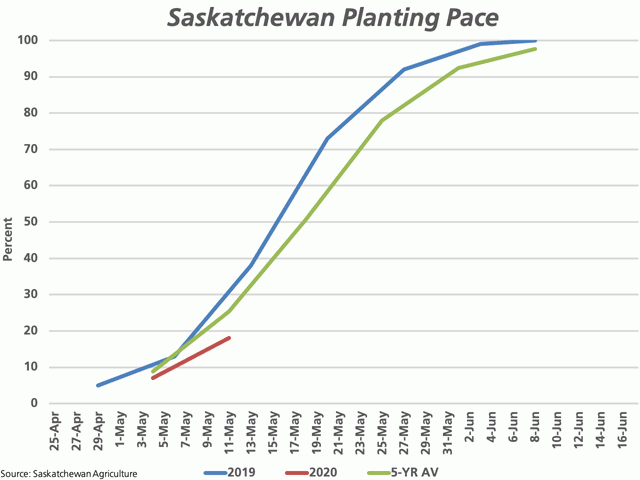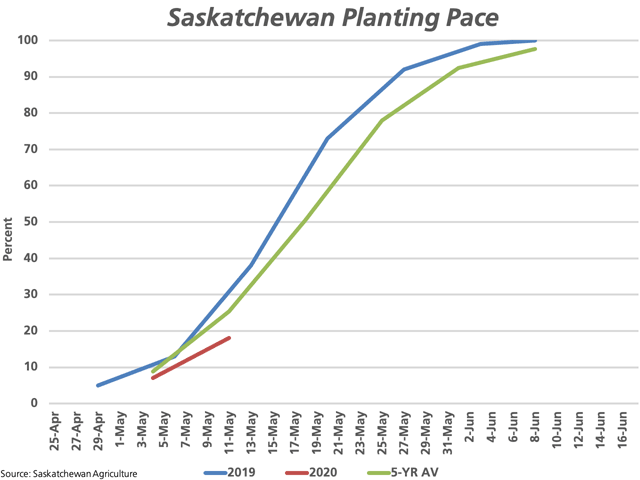Canada Markets
A Look at Saskatchewan's Seeding Progress
Saskatchewan seeding progress remains off to a slow start. The Saskatchewan government estimates that 18% of the province's crop was seeded as of May 11, up from 7% last week. This compares to the 38% seeded as of this week in 2019 and the five-year average of 25%.
The week-over-week jump of 11 percentage points is behind the 17-point average realized over the past five years. Over this period, three years saw a faster pace reported, ranging from a 20- to 25-point jump over this week (2015, 2016 and 2019), while two years were slower, with an 8-point jump in 2018 and a 10-point jump in 2017.
The 18% of the area seeded continues to remain ahead of the pace set in 2017 and 2018, when an estimated 11% and 9% of the acres were seeded as of mid-May, respectively. A quick look at Statistics Canada data shows the estimated yields for both of these years for both canola and spring wheat were higher than their respective five-year average.
Of the six regions of the province, all are behind their five-year average pace of planting. An estimated 39% of the acres are seeded in the Southwest Region as of May 11, just 2 percentage points behind the five-year average for the region. Weather challenges have slowed the Southeast Region, with an estimated 23% of the acres seeded, down 16 percentage points from the region's five-year average. This is the furthest behind, relative to the average pace, seen for any of the six regions. Over the past five years, the pace of spring seeding was closer to 50% complete in three of the five years for this region.
P[L1] D[0x0] M[300x250] OOP[F] ADUNIT[] T[]
The other four regions range from 4 to 9 percentage points behind average. With planting 3% complete in the Northeast Region, the pace is close to the slowest pace seen over the past five years.
The province's estimates for topsoil moisture were reported close to steady from last week but signal a huge improvement over one year ago. An estimated 84% of the province is rated adequate topsoil moisture, while 11% of the province is rated short. This compares to this time last year when 52% of the area was rated adequate, 40% rated short and 14% rated very short. The adequate rating of 84% is the highest reported for this week in any of the past five years, with the average reported at 68%.
Low temperatures have been a factor, as they were in 2019. Agriculture and Agri-Food Canada's agroclimate maps shows the monthly mean temperature difference from normal over the April 14-through-May 11 period ranging from zero to 3 degrees Celsius below normal across most of the province, just as the historic map shows for the spring (April 16-through-May 13) of 2019.
**
DTN 360 Poll
This week's DTN 360 Poll asks what you think will be the most likely revision we will see in the seeded-acre estimates released by Statistics Canada due to the challenges faced in surveying for the March Intentions report? This poll is found on the lower-right side of your DTN Canada Home Page. We thank you for sharing your opinions.
Cliff Jamieson can be reached at cliff.jamieson@dtn.com
Follow him on Twitter @Cliff Jamieson
© (c) Copyright 2020 DTN, LLC. All rights reserved.





Comments
To comment, please Log In or Join our Community .